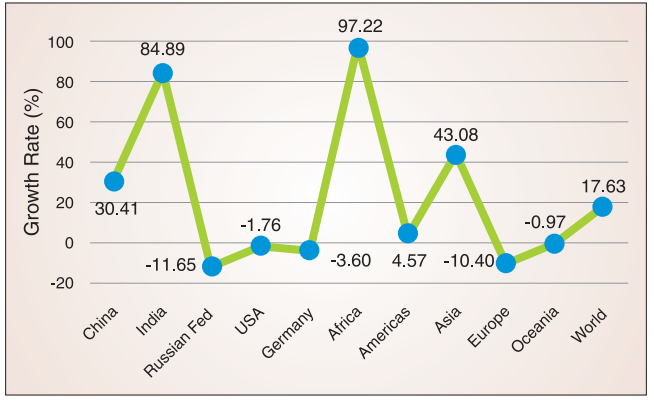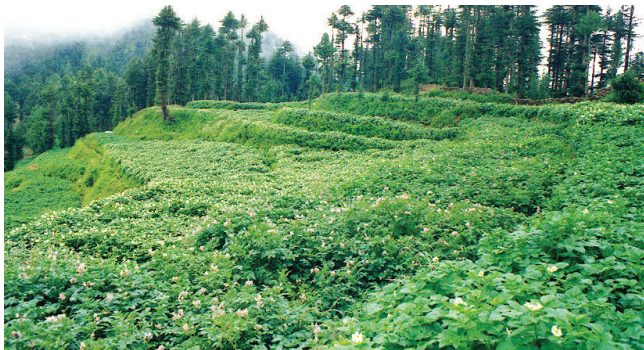Aperusal of various R&D efforts and outcomes in the field of agriculture in general and, more specifically the potato, reveals that “Business as Usual” scenario would not hold much longer. We have to anticipate and get ready to tackle much more complex and diverse future challenges in our respective fields. As the time lag between research and development efforts and the final application/adoption of the output may stretch over decades, a long term vision and blueprint of action plan is highly important for any organisation/institute. CPRI Vision 2050 is an effort to envisage long term state of affairs of potato industry in India and formulate a strategy to fulfil national needs through a well- documented plan to tackle anticipated challenges.
An ideal research agenda should include short, medium and long term concerns of the country with respect to the mandate of an organisation. Research output in the form of technologies comes after considerable time lag while desirable adoption of such technologies takes much longer time.
Future challenges in potato R&D being much more complex and difficult to be addressed, our preparedness has to be much more rigorous, precise and should extend over longer period of time. With every new addition to our knowledge on impending issues like climate change and their implications on potato industry we need to envisage more robust and superior strategies to deal with them. Development of every new vision document of CPRI provides an opportunity to assess the relevance of strategies designed and put forth in the light of unanticipated recent developments having bearing on the future of Indian agriculture as well as potato industry. Based on past experience we can visualise that several of the developments were not possible to be envisioned. Therefore development of a new vision document provides us an opportunity to make midterm course corrections and embark on a better strategy with higher probability of success in the future. CPRI Vision 2050 will serve as a light house for future potato R&D voyage.
Potato in Indian Agricultural Economy
Agriculture, including allied activities, contributed 13.9% of the
GDP at constant prices (2004-05) in 2013-14 (Anonymous, 2014) while this sector still accounts for 54.6% of total employment in the country (Anonymous, 2011). Current share of potato to agricultural GDP is 2.86% out of 1.32% cultivable area. On the contrary, the two principal food crops, rice and wheat, contribute 18.25% and 8.22% of agricultural GDP, respectively from 31.19 and 20.56% cultivable area, respectively (FAOSTAT). It indicates that contribution of potato in agricultural GDP from unit area of cultivable land is about 3.7 times higher than rice and 5.4 times higher than wheat.
Potato being a labour-intensive crop requires about 145 man days for cultivation of one ha of land. Thus nearly 289 million man- days of employment have been generated only for potato cultivation during 2013. Besides, large number of semi-skilled labour is required for carrying out post-harvest operations like transportation, storage, processing, marketing etc. Moreover, about 75% of the total labour force employed in potato cultivation is constituted by the women. Therefore, potato encourages gender equality in agricultural labour market. Inputintensive nature of potato crop helps in overall economic development of the country by supporting other sectors of the economy like industry, finance and services. For example, relatively higher demand of fertilizer, pesticide, farm machineries, cold storage equipment and structures, packaging materials, etc. for potato cultivation enables healthy industrial growth. Similarly, the crop supports services sectors through agricultural loans, insurance, marketing and technical consultancy etc.
Potato is the third most important food crop in the world after rice and wheat. Global annual potato production during the triennium ending (TE) 2013 was 370 million t resulting in per capita availability of over 50 kg. As per FAOSTAT, India is the second largest annual producer of potato after China, leaving the Russian Federation far behind (43.1, 88.2 and 30.8 million t, respectively, during TE 2013). Developed countries were the major potato producers as well as consumers till the last millennium. A comparison of potato production growth during TE 2003 and TE 2013 showed that Africa (97%) experienced the highest proportionate growth followed by Asia (Fig. 1). India and China were not only the major contributors to the Asian growth of potato production but being producer of one third global potato, contributed significantly to world potato production. Potato consumption in India and China is accelerating due to increasing industrialization and participation of women in the job market that created demand for processed, ready-to-eat convenience food, particularly in urban areas.

During the last decade developed world has experienced fall in per capita potato consumption (Americas, Europe, Oceania, Russian Federation having -8.8, -9.4, -8.3 and -2.4% growth in per capita potato consumption, respectively), while at the same time per capita potato consumption in the developing world showed increasing trend [Africa, Asia, India (in addition to the potato consumption increase due to rapid population growth), China showed 40.6, 25.6, 37.1 and 28.8% growth in per capita potato demand, respectively] during the TE 2001 and 2011 (FAOSTAT). In absolute terms Asia is the biggest gainer in per capita as well as total potato consumption over this period. However, the productivity in most of the developing countries continues to be very low.
At present in India, about 68% of potato production is consumed as fresh while the rest is utilized as seed (8.5%) and processing purposes (7.5%)or the remaining goes as waste (16%) due to various reasons that includes rottage and wastage during the entire potato supply chain. After accounting for rapid growth of potato processing due to fast economic development of the country (Rana, 2011; Singh and Rana, 2012), lower proportionate growth rate of seed demand (due to higher
Potato Crop
productivity), rise in per capita consumption of fresh potato [rapid urbanisation, future role of potato in food security (Thiele et al., 2010; Singh and Rana, 2013) and fast economic development] and as a result of ongoing efforts to lower post-harvest losses, the estimated demand of potatoes in 2050 is about 122 million t.
In addition to the estimated demand it is likely that potato tubers will be used as animal feed and for other industrial uses such as potato starch manufacturing in the future. The net export of potato tubers from India is also likely to increase in the form of seed potato and processed potato products, from the current average of a meagre 0.1 million t per year. However, due to non existing potato starch industry, absence of trends for using potato as animal feed, and numerous international variables as determinants of Indian export of seed potato and processed potato products, it is difficult to estimate future targets for the said uses of potatoes. However, using professional judgment a target of 3 million t during 2050 is assigned to all these three uses collectively. Hence, we would require potato production of about 125 million t in 2050 (Table 5)at an ACGRs of 3.2%.
Productivity and profitability of potato will determine future growth of this crop in India. Considering more or less stagnant cultivable land and impending food insecurity threat in the country we will have to strive very hard in the direction of increasing productivity of the crop. The WOFOST model estimates indicate that at present level of
Potato Tuber
technological intervention the achievable yield of potato in India would be 35.95 t/ha during the year 2050. However, due to the technological advancement at NARS level the achievable yield during 2050 would be 43.14 t/ha.
At present level of farm management practices we are actually able to harvest only 42-45% of the achievable yield. However, an enhanced emphasis on efficient dissemination of farm technologies and consequent improvement in farm management practices in the country, it is estimated that we would be able to harvest 80% of achievable yield in 2050 which would result in estimated yield of 34.51 t/ha. Potato productivity in India is required to rise at an ACGR of 1.46% up to the year 2050 in order to meet this yield target.
The projected potato area based on the ACGRs of last 40 years is not possible to achieve as country has already about 46% (141.4 million ha) of the total geographical part as net sown area. Further increase in cultivable area in the country is likely to cause huge environmental damage. Fast increment in land used for non agricultural purposes makes this expansion still more difficult. NCAP has forecasted net sown area in the country during 2050 at 142.6 million ha which is more or less same as during 2010. Therefore, primary goal of future potato R&D in India in general, and at CPRI in particular, would be increasing average potato productivity in the country to 34.51 t/ha during the year 2050. The potato production targets as dictated by the corresponding demand of potatoes for various uses would be met with the adjustment in the area. Higher or lower demand will be reflected in prices which will consequently affect farmers’ profitability and ultimately the area under potatoes will automatically be adjusted.
At estimated production and yield targets, we would require 3.62 million ha of area under potato. However, availability of this enhanced area under potato cultivation in future needs to be critically analysed. Higher per unit (area and time) production potential of potato crop compared to other food crops will help getting higher allocation of area under this crop in the future. Rice and wheat have 41.85 and 27.75 million ha area under cultivation in India and potato is generally taken as a sequence crop with both these crops. With the ongoing efforts of developing short duration potato varieties and tropicalization of the crop, faster mobility of perishable crops on account of upcoming dedicated freight corridors of Indian Railways, potato emerging as an important food security option in India, and elevated demand will bring needed area under potato through relative improvement in crop profitability.








